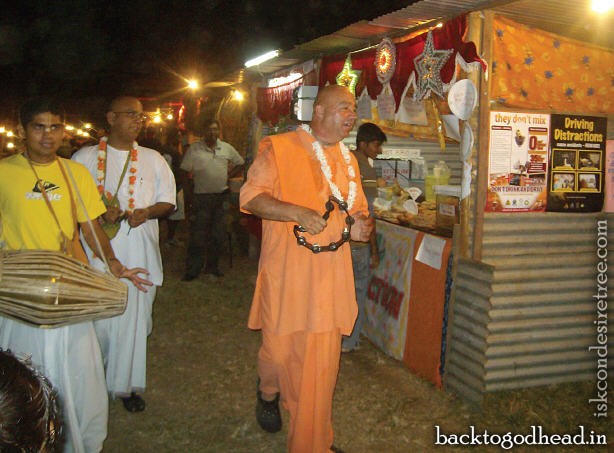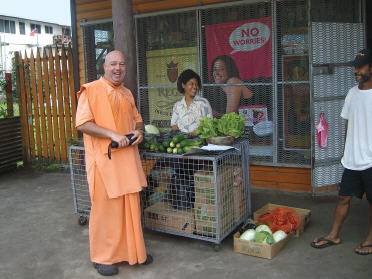
In my opinion , walking is the best mode of transportation even when we live in the age of automation. Srila Prabhupada used to walk every day. For thousands of years sannyasis, renounced men of India, have walked. A sannyasi myself, I took inspiration from Srila Prabhupada and others and decided fifteen years ago to trek, not in ancient India just then, but in a portion of the New World, Canada, which doesn’t yet have a reputation for pilgrimage. By the grace of Krishna I have now crossed Canada three times to spread Krishna consciousness. I’ve also walked in Ireland (from Belfast to Cork) and in Guyana. When I received an invitation to go to Fiji, that distant and exotic place in the South Pacific, it became my latest frontier for pilgrimage walking.
Before I set off on the Queen’s Road from Suva on the southeast coast of the main island to Lautoka in the northwest, my Fiji hosts and I decided to produce a handout. The message highlighted the need for us all to relate more as spirit souls and less as the body, such as this or that type of Fijian. The spiritual message ahaμ brahmasi “I am spirit” challenges the false notion of bodily identity that is often a point of contention, whether in Fiji or anywhere else.
We included in bold print the maha-mantra for inner peace: Hare Krishna, Hare Krishna, Krishna Krishna, Hare Hare/ Hare Rama, Hare Rama, Rama Rama, Hare Hare. We gave this translation: “O beautiful Creator, please allow me to joyfully contribute to serving You and Your creation.” Armed with this message, as well as japa chanting beads, my orange robes, a reliable pair of Croc footwear, and a whole lot of moral support from the Fiji devotee community, I began my walk through Fiji.
Day One Sunday, August 23, 2009 Suva
Krishna states in the Bhagavad-gita, “I am adventure,” and so, here it is.I’m groping around in the dark at 4:30 A.M. with some walking companions, people I met only the night before. I’m in a strange country, trekking down a coastal road bordering a coral reef, dodging the odd drunken driver. I don’t know what’s around the corner. As dawn comes, so too come the people.
My sponsor for this trip, Fijiborn Radha-Madhava Dasa, taught me how to address people. “Bula!” is the way to say hello. You never find anyone who doesn’t respond with warmth.
Geraldine Panapasa from the Fiji Times caught up with me at a brunch break. I explained to her that life in the modern world, with its excessiveness and consumerism, poses a great imbalance in our lives.
“There is a need to reserve a part of our day for spiritual activities,” I said. “For physical and spiritual well-being we can fuse walking and mantra meditation to check this imbalance.”
I showed Geraldine my beads and recited the maha-mantra. She liked my program and decided she had a story.
By midday I had another break, this time at the Suva temple, where I led a kirtana. The attendees were accustomed to chanting but enjoyed learning some simple dance steps to accompany the song.
Day Two Monday, August 24 Nauva
As the day wore on, fatigue struck. Exhaustion. Too much sun. Uneven ground and a stony shoulder to the road made walking uncomfortable for my feet. But I took it as a challenge. Austerity is a veritable obligation for a sannyasi. It is a type of self-imposed inconvenience that converts into a pleasurable experience in this “less is more” lifestyle. It brings you closer to Krishna.
The two men I started trekking with today gave in after 15 km of the austerity. I’ll admit, they did their best. So I walked alone. Fortunately none of us is ever alone. Krishna is always in the heart. Yogis in the past would perform dhyana (meditation) alone in the forest and sustain a level of contentedness, knowing of the presence of Paramatma, God in the heart.
The hours passed by. The heat persisted. One kind soul saw that I was parched. He got out his bamboo rod and knocked off a coconut from the top of one of his trees. He came forward with a beaming smile, eager to offer this refresher. In this small way by giving to a sannyasi walking in service to Krishna his devotional life began.
Day Three Tuesday, August 25 Pacific Harbour
As we walked along the route, Radha-Madhava, my stalwart associate, was telling native folks, “Talatala,” which means “priest.” Fijians seem to have a natural reverence for the spiritual person. At some of these villages you just stand there in devotional garb and the people come out of their homes to greet you. So imagine what the response would be with the added features of chanting, drumming, and dancing, as was done during the time of Sri Caitanya, the sannyasi and incarnation of Krishna who inspired sankirtana (group chanting) early in the sixteenth century.
A young man, Elike, 15, came forward to tell us that his brother Daniel had lived in ISKCON’s Lautoka temple. Daniel had left and become much like a recluse, residing in a tent on the beach. Radha-Madhava sought him out and brought him to the road to join us. He decided to stay for the duration of the Fiji walking mission and became enthusiastic to have Krishna back in his life. Distance walked: 31 km.
Day Four Wednesday, August 26 Sigatoka
Daniel and I, along with Rasa Mandala, a brahmacari (young male student) from the Suva temple, took to the road shortly after 4 A.M. to enter into what is called “the salad bowl of Fiji,” where you find orchards of papaya and fields of sugarcane, cassava, and taro root. Upon entering the city of Sigatoka, our party increased in number and we performed sankirtana, singing the Hare Krishna maha-mantra for the benefit of onlookers.
A farmer invited us to his stall inside a huge farmer’s-market building where we could perform. Rasa played the drum, and everyone else synchronized with instruments and voices. Vendors, visitors, tourists, and shoppers froze, looked, and listened with delight. Once we stopped, people came forward Hindus, Christians, and Muslims alike to offer their appreciation. It was a great moment. We felt the presence of Sri Caitanya. Distance walked: 30 km.
Day Five Thursday, August 27 Nadi

By now many people had become aware of the monk walking, as national TV and newspapers covered the story, but I met two fellows who didn’t have a clue who I was or what I was about. Our nighttime sleep took place in a farmer’s home, which the owners had graciously opened up to us. At 3 A.M., while my three companions were showering and preparing to catch up to me, I began walking down a quiet country dirt road leading to Queens Road. I carried a small flashlight for that two-kilometer stretch and startled two natives squatted at the edge of a sugarcane field. The light shone in their eyes.
Feeling threatened, they demanded, “What are you?”
“Bula! I am a walking talatala.”
They were either intoxicated or superstitious or both. One of them came forward cautiously. He looked at my bald white head, the tilaka mark on my forehead, and my robes. He was particularly taken by the robes.
“Do you have legs?” he demanded, shivering in fear.
I showed him my ankles to let him know I wasn’t a ghost. He was relieved, and his skepticism subsided. I felt it my duty to share with him the spiritually elevating words “Hare Krishna!”
Eventually he shook my hand and asked, “Where are you from?”
“Canada!”
“Take me there!” he insisted.
“No, no! We need to work our way back to God. Agreed?”
“Yes!” said the chap.
Srila Prabhupada would always say that our aim in life is to return to our spiritual home, the abode of Krishna. Distance walked: 40 km.
Day Six Friday, August 28 Lautoka
It has been my experience that in the course of marathon walking, the heart softens just upon seeing and meeting people. Essentially we are all servants of the same supreme spirit. We are all part of the same universal family, despite differences in lifestyle and activity.
While in stride I saw powerful images: a group of men firing stones for a lovo (an outside roast of cassava or perhaps mongoose), a woman watering her outdoor plants with utmost care, calves eagerly suckling from their mother’s udder. I also spotted men toiling in sugarcane fields. They put in many hours under a blazing sun, day after day, and for the most part without complaining. You can’t help feeling for them. In the Vedic scriptures the appropriate phrase is para-dukha-dukhi, which means you feel some anguish over the anguish of others. Life is indeed a hard struggle when one must contend with problems from the body and mind, other living beings, and the elements.
Standing alongside the highway was one of those sugarcane workers. He looked a bit depressed, so I asked him what was wrong.
“I lost my job.” he replied.
“Sorry to hear that,” I said, sympathizing.
“What are you doing?”
“I’m a pilgrim, and I’m walking for God,” I said.
He introduced himself as Tuks. Deciding to join me, he set aside his duffle bag of clothes and sleeping gear and set it in the bushes to gather later. Onward we marched.

Tuks asked if I believe in Christ, and I said, “Yes, Jesus is the son of God. Krishna is the father. In the sacred book Bhagavad-gita Krishna identifies Himself as the father of all. Their father and son relationship is very strong. Krishna and Christ are very compatible.”
Tuks told me that he was a father. We walked and talked the rest of the day.
Daniel joined us for the last leg of the journey. The heat was intense, and the last few steps were somewhat grueling. But that’s just that sweet austerity kicking in again. Our finish line was at ISKCON’s famous Krishna Kaliya temple. There we met the mayor of Lautoka, who congratulated us for “a marvelous feat.” Our six-day journey across Fiji came to a close. Distance walked: 40 km.
Legs and Mouth Serving the Absolute
I find there is no better or more personal way to meet people than with the low-tech, high-organic approach of using your legs. These legs were made for walking. And the mouth was meant for speaking about the Absolute. What a perfect combination! These legs are also meant for dancing. In the few days to follow this six-day venture, two most helpful devotees, Jaya Rama and his son Visvanatha, arranged for Daniel’s village, Navutulevu, to receive piping-hot prasadam. Rasa and Daniel beat drums. The village chief danced to the beat, signifying the approval for others to dance to the sound of the drums and the maha-mantra.
Food, singing, dancing, and a few words about Krishna that’s culture! Cannibalism was once a way of life here. People have come a long way from that. It was good to see the fun, with Sri Caitanya’s mercy evident in the happy faces.
Bhaktimarga Swami is an ISKCON governing body commissioner with responsibility for parts of Canada. When not on the road, he lives at the Toronto temple.
